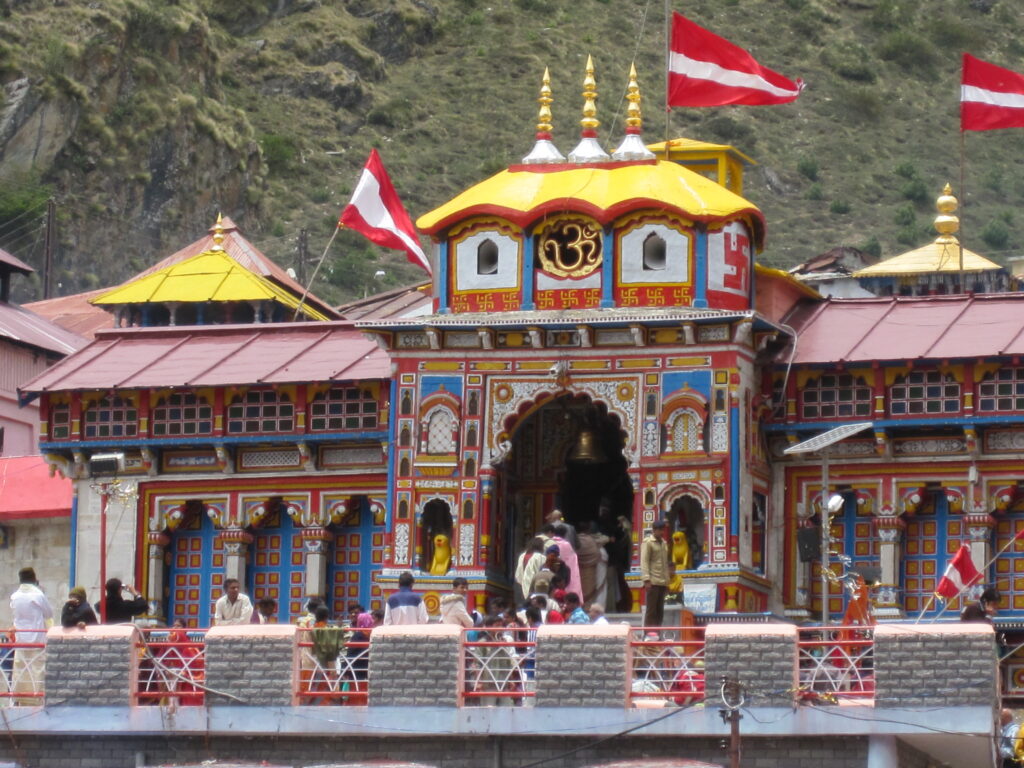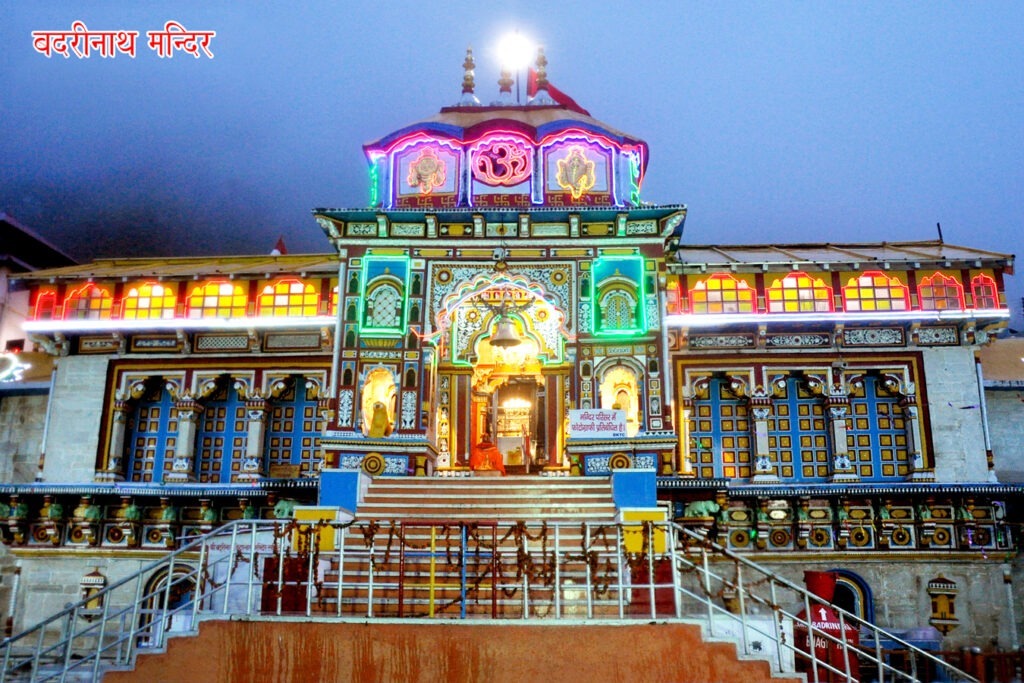
Badrinath Temple, Uttarakhand
Badrinath Temple, located in the state of Uttarakhand, India, is one of the most revered and ancient Hindu temples dedicated to Lord Vishnu. Situated in the picturesque town of Badrinath in the Garhwal Himalayas, the temple holds immense religious significance and is a key pilgrimage site as part of the Char Dham Yatra. The temple is surrounded by breathtaking mountain scenery and is one of the holiest shrines in Hinduism, attracting devotees from across the country and beyond.
Namaste 🙏 नमस्ते
Secure your visit • अपनी यात्रा सुरक्षित करें
Historical background and Architectural splendor
This temple’s history dates back to ancient times, with references in various Hindu scriptures like the Vishnu Purana. It is believed to have been established by Adi Shankaracharya in the 8th century, although the temple underwent several renovations and rebuilds over the centuries. The current structure is said to have been constructed in the 16th century by the Garhwal kings. The temple has withstood natural calamities and remains a symbol of religious resilience.
This temple showcases traditional Himalayan temple architecture with its distinct conical-shaped shikara (spire) and intricate wood carvings. The exterior is adorned with vibrant colors, and the main entrance, known as the Singh Dwara, features a sculpture of Lord Vishnu’s vehicle, the Garuda. The sanctum sanctorum houses the sacred deity of Badrinath, a black stone idol of Lord Vishnu, seated in a meditative pose. The Mandapa (assembly hall) and the ardha-mandapa exhibit exquisite craftsmanship with detailed carvings depicting various mythological stories. The temple’s location against the backdrop of the snow-clad Himalayas adds to its architectural grandeur and spiritual allure.

Religious Significance
Badrinath Temple, ensconced in the Himalayas, holds profound religious significance in Hinduism as one of the Char Dhams, comprising four sacred pilgrimage sites. Dedicated to Lord Vishnu in the form of Badrinarayan, the temple is revered as the abode where the deity blesses and safeguards devotees. As an integral part of the Char Dham Yatra circuit, which includes Yamunotri, Gangotri, and Kedarnath, Badrinath draws pilgrims seeking spiritual merit and purification from sins. Its ancient roots, mentioned in Hindu scriptures, elevate it as one of India's oldest and holiest pilgrimage destinations. Pilgrims believe that seeking Lord Vishnu's blessings here can lead to moksha, liberating them from the cycle of rebirth. Rituals at Brahma Kapal on the Alaknanda River's banks and sacred features like Tapta Kund, Narada Kund, and Mata Murthy contribute to the site's sanctity. Beyond its physical presence, Badrinath Temple serves as a spiritual beacon, attracting devotees in pursuit of divine blessings, spiritual elevation, and a profound connection with Lord Vishnu.

Festival and Celebrations
The festivals and celebrations add vibrancy to the spiritual ambiance of Badrinath Temple, attracting pilgrims and tourists alike to partake in the religious and cultural fervor. Special occasions celebrated here are opening and closing ceremonies, Mata Murti Ka Mela, Badrinath Kapat Opening and Badri-Kedar Festival, Ganga Dussehra, Makar Sankranti, Krishna Janmashtami, and Diwali.
Surroundings area & attractions
- Mana Village: Mana, the last village before the Indo-China border, is a picturesque hamlet known for its scenic beauty and proximity to Badrinath. It has the Vyas Cave, where Sage Vyas is believed to have composed the Mahabharata.
- Bheem Pul: Located near Mana Village, Bheem Pul is a massive rock forming a natural bridge over the Saraswati River. According to mythology, Bheema, one of the Pandava brothers, placed this rock to help Draupadi cross the river.
- Tapt Kund: Located near the Badrinath Temple, Tapt Kund is a natural hot water spring where pilgrims take a ritual dip before entering the temple. The water is believed to have medicinal properties.
- Charan Paduka: A rock bearing the footprints of Lord Vishnu is known as Charan Paduka. It is believed that Lord Vishnu stepped on this rock during his descent to Earth.
- Narad Kund: It is a natural thermal spring near Tapt Kund, and it is believed to be the source of the Alaknanda River. Pilgrims often take a holy dip in its warm waters.
- Joshimath: A town near Badrinath, Joshimath serves as a base for treks and is home to the sacred temple of Narasimha, an incarnation of Lord Vishnu.
- Hemkund Sahib: A Sikh pilgrimage site near Badrinath, Hemkund Sahib is a high-altitude lake surrounded by seven snow-capped peaks. It is visited by Sikhs and Hindus alike.
FAQ
The Badrinath Temple is located in the town of Badrinath in the Chamoli district of Uttarakhand, India.
The presiding deity of the Badrinath Temple is Lord Badrinath, a form of Lord Vishnu.
The Badrinath Temple is one of the Char Dham pilgrimage sites and is considered one of the holiest Hindu temples dedicated to Lord Vishnu. It is also part of the Chota Char Dham circuit in Uttarakhand.
The Badrinath Temple is believed to have been established by Adi Shankaracharya in the 8th century CE. It has undergone several renovations and rebuilds over the centuries, with the current structure dating back to the 19th century.
The Badrinath Temple features traditional Hindu temple architecture with a tall spire (shikara) and intricate carvings depicting various deities and mythological scenes. The temple is made of stone and stands against the backdrop of the majestic Himalayas.
The main rituals and ceremonies at the Badrinath Temple include the morning and evening aarti (worship with lamps), abhishekam (ritual bathing of the deity), and special offerings made by devotees.
The Brahma Kapal is a sacred ghat located near the Badrinath Temple where devotees perform rituals and offer prayers for their ancestors. It is believed that performing these rituals at Brahma Kapal helps liberate the souls of ancestors.
The Badrinath Temple is open for pilgrims from April to November, coinciding with the summer and autumn months in the region. The temple remains closed during the winter due to heavy snowfall.
Yes, there are accommodation options available for visitors and pilgrims near the Badrinath Temple, including guesthouses, dharamshalas, and hotels. These accommodations cater to the needs of pilgrims during their stay in Badrinath.
The Alaknanda River, a tributary of the Ganges, flows near the Badrinath Temple. It is considered sacred by devotees, who take holy dips in its waters as part of their pilgrimage rituals, believing it purifies them spiritually.
According to Hindu mythology, Lord Vishnu meditated at the site of the Badrinath Temple for thousands of years under the Badri tree. It is also believed that Adi Shankaracharya rediscovered the deity of Lord Badrinath from the Narad Kund and established the temple.
Badrinath is part of the Panch Badri pilgrimage circuit, which consists of five temples dedicated to Lord Vishnu. The other four temples in the circuit are Adi Badri, Yogadhyan Badri, Bhavishya Badri, and Vriddha Badri, each with its own significance and legends.
Yes, there are several nearby attractions that pilgrims can visit along with the Badrinath Temple, including Mana Village (the last village before the Indo-China border), Vyas Cave (associated with Sage Vyas), and Charanpaduka (footprints of Lord Vishnu).
Pilgrims can reach Badrinath by road, either by private vehicles or public transport buses. The nearest railway station is Rishikesh, and the nearest airport is Jolly Grant Airport in Dehradun. From there, one can travel by road to Badrinath.
Yes, the Neelkanth Peak, visible from Badrinath, is considered sacred in Hindu mythology. It is believed to be the place where Lord Shiva consumed the poison Halahala during the churning of the ocean (Samudra Manthan), thus turning his throat blue (Neelkanth).
The darshan timings at the Badrinath Temple vary depending on the time of year and specific rituals being performed. Generally, the temple opens in the morning and closes in the evening, with specific timings for various rituals and aarti.
While there is no strict dress code, pilgrims are encouraged to dress modestly and respectfully while visiting the Badrinath Temple. It is customary to remove shoes before entering the temple premises and to wear appropriate clothing.
There are various accommodation options available for pilgrims in Badrinath, including guesthouses, dharamshalas (pilgrims’ rest houses), and private hotels. Pilgrims can choose accommodation based on their budget and preferences.
Photography is generally allowed inside the Badrinath Temple premises, but it is advisable to check with the temple authorities.
Visitor information
Entry Fee: No fee
Priority Darshan slips cost around Rs. 2,500 per yatri and are available at the helipad.
Timings :
- 6 am–12 pm
- 4pm –9 pm
Darshan Days- From April/May to October/November
Address:
Badri to Mata Murti road, Badrinath, Uttarakhand 246422
Notable Events and Incidents
- Badrinath Utsav (Annual Festival)
- Flash Floods in Uttarakhand
- Centenary Celebrations
- Prime Minister's Visit
- Char Dham Yatra Pilgrimage
Connectivity :
- By Road: Badrinath is well-connected by road networks through the Himalayas National Highway 7 (NH7). It connects Badrinath to major cities like Rishikesh and Haridwar.
- By Air: The nearest airport to Badrinath is the Jolly Grant Airport in Dehradun, approximately 314 kilometers away.
- By Rail: The nearest major railway station is Rishikesh, located about 293 kilometers away from Badrinath.
- Helicopter Services: Helicopter services are available for those seeking a faster mode of transportation. Helipads near Badrinath offer convenient access, especially during peak pilgrimage seasons.
- Pony and Porters: For those who prefer trekking, ponies and porters are available for hire, particularly for the trek from Govindghat to Badrinath.
- Road Conditions: The road leading to Badrinath may be subject to closure during winter due to heavy snowfall. Pilgrims are advised to check the road conditions and plan their travel accordingly.
- Local Transport: Within the town of Badrinath, local transport options include auto-rickshaws and taxis for commuting to nearby attractions and pilgrimage sites.
